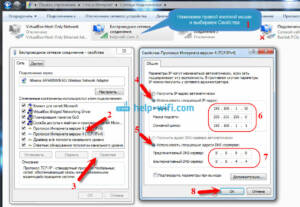Step 1: Prepare to connect Wi-Fi on your smartphone
Before you connect Wi-Fi on your smartphone, you need to prepare the device for working with a wireless network. First of all, make sure that Wi-Fi is turned on on your smartphone. This can be done in the device settings, in the 'Network and Internet' section. Also, before connecting to Wi-Fi on your smartphone, check for available Wi-Fi networks in your area. To do this, open the Wi-Fi settings on your device and wait until the smartphone finds all available networks in your area. If you plan to connect to a secure Wi-Fi network, you need to make sure you know the password to access it. If the password is unknown, contact the network owner and request it. Once you have prepared your smartphone to work with Wi-Fi, you can proceed to setting up a connection to a wireless network.
Step 1.
1: Check for Wi-Fi on your smartphone
Before you connect Wi-Fi on your smartphone, make sure that your device has Wi-Fi functionality. Many smartphones already have this feature by default, but if your phone is older or budget, it may not have Wi-Fi.
To check the availability of Wi-Fi on your smartphone, open your phone's settings and find the 'Network and Internet' section. If there is a 'Wi-Fi' option in this section, then your phone supports this feature.
If there is no Wi-Fi on your smartphone, then you can use the mobile Internet to connect to the network. But keep in mind that this may be more expensive than using Wi-Fi, especially if you frequently download large files or watch high-quality videos.
Don't forget to also check if Wi-Fi is turned on on your phone. To do this, open your Wi-Fi settings and make sure the feature is enabled. If Wi-Fi is turned off, then your phone will not be able to connect to the network and you will not be able to use the Internet via Wi-Fi.
Step 1.
2: Select Wi-Fi hotspot
Once you have enabled Wi-Fi on your smartphone, you need to select an available Wi-Fi hotspot. To do this, follow the instructions:
- Open the Wi-Fi setup menu on your smartphone.
- A list of available Wi-Fi access points will be displayed on the screen.
- Select the desired access point from the list.
- If the access point is password protected, enter the password.
- Click the 'Connect' button.
If you can't find an available Wi-Fi hotspot, try moving closer to your router or rebooting your router. If the problem persists, contact your Wi-Fi provider.
Step 1.
3: Enter your password
Once you select the Wi-Fi network you want, you will be asked to enter a password to connect to it. The password is usually located on the router box or on the router itself. If you do not know the password, contact the network owner or Internet service provider.
If you know the password, enter it in the appropriate field and click 'Connect'. If the password is correct, you should be connected to the Wi-Fi network.
- Make sure you are entering the correct password. Mistakes when entering your password may prevent you from connecting to the network.
- If you do not want to enter a password every time you connect to this network, check the 'Remember password' option.
- If you cannot connect to the network with the correct password, try rebooting your router or contacting your service provider.
Step 2: Solving Wi-Fi connection problems on your smartphone
If you encounter problems connecting your smartphone to Wi-Fi, then do not despair. This is a fairly common problem that can be resolved by following a few steps.
1. Check your Wi-Fi network password. Make sure you are entering the correct password. If you are unsure of the correct password, try entering it again.
2. Reboot your router. Some connection problems may be due to a faulty router. Try turning your router off and on to fix the problem.
3. Make sure Wi-Fi is turned on on your smartphone. If Wi-Fi is turned off on your smartphone, then you will not be able to connect to the network.
4. Check if your smartphone has software updates. Some connection problems may be due to an outdated software version. Try updating the software on your smartphone.
5. Try connecting to a different Wi-Fi network. If you are still having problems connecting to Wi-Fi, then try connecting to a different Wi-Fi network. This will help you figure out if the problem is related to your network.
By following these steps, you should be able to resolve most Wi-Fi connection issues on your smartphone. If you are still encountering problems, please contact your device manufacturer or contact a service center. When connecting to Wi-Fi on your smartphone, it is important to ensure that the Wi-Fi settings on your device are configured correctly. Enter the Wi-Fi settings on your smartphone and make sure the Wi-Fi feature is turned on. If you see available Wi-Fi networks on your smartphone but can't connect to them, try restarting your device and re-entering Wi-Fi settings. If the problem persists, try moving closer to the router to make sure the Wi-Fi signal is strong enough. If you still can't connect to Wi-Fi, try forgetting the Wi-Fi network and reconnecting to it by entering the correct password.
Step 2.
2: Reboot your router
Often, Wi-Fi connection problems can be caused by a simple faulty router. Rebooting may help resolve this issue. To reboot your router, follow the manufacturer's instructions.
Typically, you need to follow these steps to reboot your router:
1. Turn off your router.
2. Disconnect it from the power supply.
3. Wait a few seconds.
4. Connect the router to power.
5. Turn it on.
After rebooting your router, try connecting to Wi-Fi again. If the problem is not resolved, proceed to the next step.
Step 2.
3: Contact your Internet Service Provider
If you can't set up Wi-Fi on your smartphone yourself, contact your Internet service provider for help. They will be able to provide you with the necessary settings and connect your device to the Wi-Fi network.
To contact a provider, find their contact information on their website or in your service agreement. When applying, make sure that you have all the necessary data, such as login and password for your account.
Providers may also offer you to upgrade your equipment for a more stable and faster Wi-Fi connection. They will also be able to answer any questions you may have during the setup process.
Don't hesitate to ask for help if you need additional support. Properly configured Wi-Fi on your smartphone can greatly improve your internet experience and increase your productivity.
Read further:






